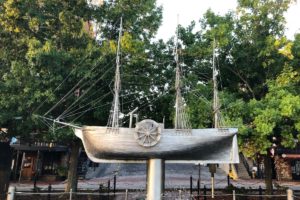
Here’s an attractive dome buoyed by sunlight. What and where is it? Send to feedback@statehousereport.com. And don’t forget to include your name and the town in which you live.
Our previous Mystery Photo
 Our Oct. 16 photo, “Monument to shipping,” showed a metal model of the SS Savannah, the first steamship to cross the Atlantic Ocean. The picture was taken along the riverwalk in Savannah along the Savannah River.
Our Oct. 16 photo, “Monument to shipping,” showed a metal model of the SS Savannah, the first steamship to cross the Atlantic Ocean. The picture was taken along the riverwalk in Savannah along the Savannah River.
Congratulations to these intrepid photo detectives for identifying it: George Graf of Palmyra, Va.; Allan Peel of San Antonio, Texas; Kevin Mertens of Greenville; Philip Cromer of Beaufort; and Vicki Ringer of Columbia.
Peel provided detail about the memorial: “The sculpture is located along the Savannah waterfront in the John P. Rousakis Riverfront Plaza at the corner of the historic River Street and Barnard Street in Savannah, Ga. Captained by Moses Rogers (1779-1821), this ship set sail from Savannah on May 22, 1819, and arrived in Liverpool, England, on June 20, 1819. The 98-foot, 320-ton hybrid vessel was built to operate as a side wheel steamship or a sailing ship with three masts. With 32-passenger berths and three saloons, it had an interior resembling a pleasure yacht. However, it had been dubbed the “steam coffin” and the owners had been unable to secure any passengers or freight for the trip to Liverpool, therefore it was an experimental voyage.
“The ship left Savannah on May 22, 1819 with 75 tons of coal and 25 cords of wood for fuel. It took 29 days and 11 hours to reach Liverpool but the steam engine was only employed for a total of 80 hours during the voyage. Considering that the total distance travelled (as the crow flies) was over 4,000 miles, this means that the ship was able to achieve an average speed of 5.7 mph (or 5.0 nautical mph), assuming a 24/7 sailing regiment.
“Despite the historic voyage, the Savannah failed to be a commercial success due to the great space that was taken up by the large steam-engine and its associated fuel, limiting the cargo-carrying capacity of this type of ship. In order to make ends meet, the owners of the ship had it converted to 100 percent sail shortly after its return trip from Europe in 1819. Just two years later, the SS Savannah met her fate in a devastating ship wreck off Long Island, N.Y., in 1821, coincidentally the same year that Rogers died from typhoid fever.”
Send us a mystery: If you have a photo that you believe will stump readers, send it along (but make sure to tell us what it is because it may stump us too!) Send to: feedback@statehousereport.com and mark it as a photo submission. Thanks.















 We Can Do Better, South Carolina!
We Can Do Better, South Carolina!